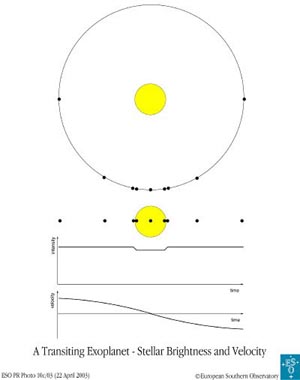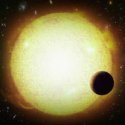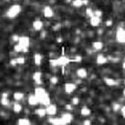A glowing hot planet with a year just 28.5 hours long has been spotted whipping around a Sun-like star by German and European Space Organisation (ESO) astronomers. The extrasolar or exoplanet is bigger than our neighbour Jupiter, but only half as massive. The information about the planet the team has so far gained could help astronomers home in on other exoplanets.
There are more than one hundred planets known so far orbiting stars other than the Sun. Orbital periods – their years – and their distance from their star can be determined accurately but it is possible with current technology and data to estimate only a lower limit on their mass. The mass problem arises because the means of detecting exoplanets is based on measuring the small but regular changes in the central star’s velocity due to the gravitational pull of the orbiting planet.

Fortunately, two exoplanets have been found the orbits of which allow them to pass in front of their star. This provides a much better view of the effect of the planets on their respective stars. The transit event causes a small and temporary dip in the star’s brightness, roughly about 2%, as the planet covers a small part of the observed surface. This information coupled with distance and period measurements allow a direct determination of the planet’s true mass to be obtained.
Now, German and ESO astronomers – Stefan Dreizler, Sonja Schuh, Wilhelm Kley, Thomas Rauch and Klaus Werner of the Institute for Astronomy and Astrophysics, in Tubingen, Germany, Peter Hauschildt of the University of Hamburg Observatory, Germany, and Burkhard Wolff of ESO, have found a third and very useful exoplanet.

The solar-type star, designated OGLE-TR-3, was observed with the high-dispersion UVES spectrograph on the Very Large Telescope (VLT) at the ESO Paranal Observatory in Chile. The OGLE in the name refers to the Optical Gravitational Lensing Experiment on which the measurements hinge. This most recently discovered exoplanet has the shortest year measured so far for any exoplanet. It orbits at a mere 3.5 million km from its star and so the hemisphere that faces the star must be extremely hot, astronomers estimate it as being at 2000 Celsius and suggest that the planet must be evaporating rapidly. The astronomers propose that this could make direct observations of this exoplanet possible because it will be emitting strong infrared radiation. The IR radiation from the planet will still be small compared to the star, but it might be detectable, Dreizler told Spotlight.

Astronomers are hunting exoplanets not simply as stamp collectors but to help them understand the diversity of planetary systems. One of the ultimate aims is to find an Earth-like exoplanet that might harbour extraterrestrial life.

Meanwhile, improvements in the conventional techniques for determining the mass of an exoplanet are being made. The new HARPS spectrograph (High Accuracy Radial Velocity Planet Searcher), now being tested on the 3.6 m telescope at the ESO La Silla Observatory, can measure the motions of stars to an accuracy of about 1 metre per second and will soon be able to spot the gravitational effects of planets only a few times the mass of the Earth and put a lower limit on such an exoplanet’s mass.
Further reading
Astronomy and Astrophysics, 2003, 402, page 791
Sonja Schuh
http://www.uni-sw.gwdg.de/~schuh/
Wilhelm Kley
http://www.tat.physik.uni-tuebingen.de/~kley/
Thomas Rauch
http://astro.uni-tuebingen.de/~rauch/
Klaus Werner
http://astro.uni-tuebingen.de/~werner/
Peter Hauschildt
http://hobbes.hs.uni-hamburg.de/~yeti/
UVES spectrograph
http://www.eso.org/sci/facilities/paranal/instruments/uves/
ESO Paranal Observatory
http://www.eso.org/sci/facilities/paranal/
HARPS spectrograph
http://www.eso.org/sci/facilities/lasilla/instruments/harps/
Suggested searches
Extrasolar planets
Echelle spectroscopy